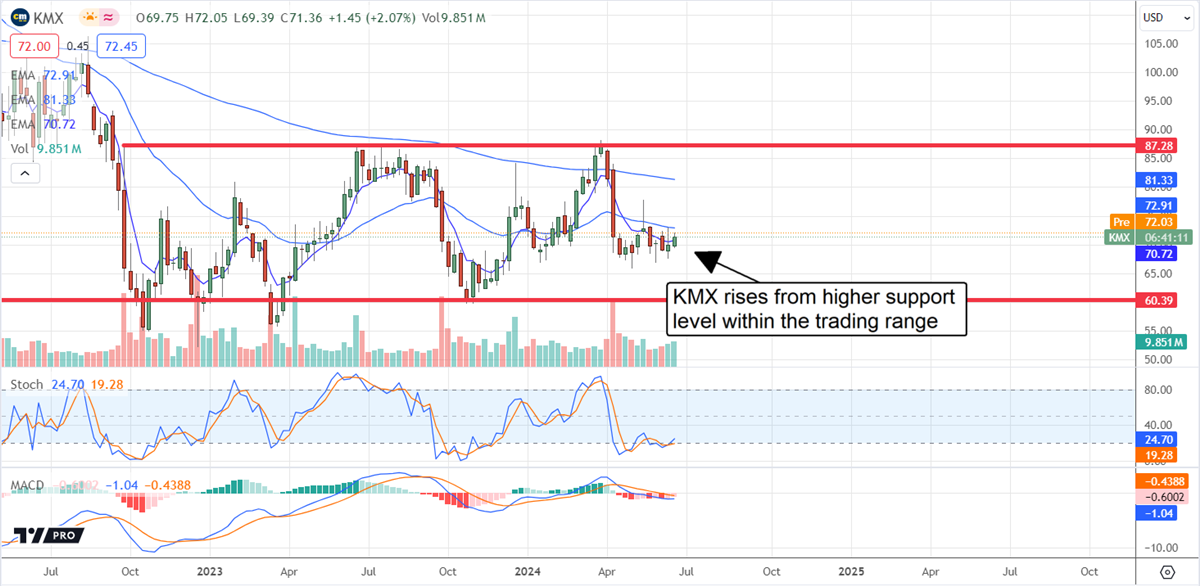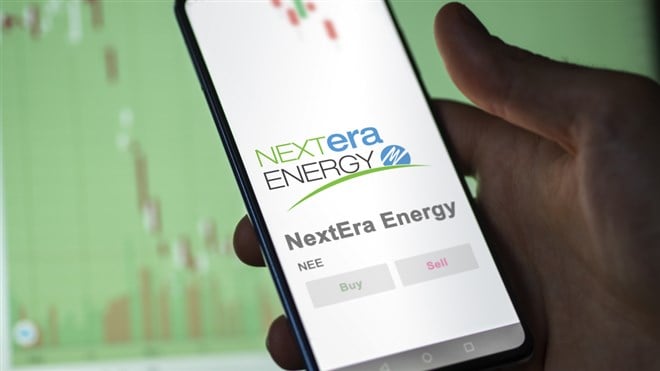Ticker Reports for June 21st
Sarepta Therapeutics Stock Soars on FDA Approval
Sarepta Therapeutics (NASDAQ: SRPT) is leading the game in precision genetic medicine and biotechnology. Sarepta Therapeutics' stock price has witnessed a surge of over 40% after receiving expanded FDA approval for its Duchenne muscular dystrophy (DMD) gene therapy, Elevidys. This pivotal decision marks a turning point in treating this debilitating disease and underscores Sarepta's commitment to developing groundbreaking therapies for rare diseases.
Duchenne Muscular Dystrophy: A Critical Need
Duchenne muscular dystrophy (DMD) is a severe genetic disorder characterized by progressive muscle degeneration and weakness. Primarily affecting boys, DMD is caused by mutations in the DMD gene, which provides instructions for creating dystrophin, a protein crucial for maintaining muscle cell structure and function. The absence of functional dystrophin leads to progressive muscle wasting, loss of mobility, and, ultimately, life-threatening complications. With an estimated incidence of 1 in 3,500 male births worldwide, DMD presents a significant unmet medical need, making the development of effective therapies an urgent global health priority.
Sarepta's Legacy of Innovation in Genetic Medicine
Founded in 1980, Sarepta Therapeutics has emerged as a pioneer in genetic medicine, particularly in developing therapies for DMD and other rare neuromuscular disorders. Driven by a mission to engineer precision genetic medicines that transform patients' lives, Sarepta has built a diverse and robust pipeline of over 40 programs. The company's innovative approach is powered by its multi-platform Precision Genetic Medicine Engine, which encompasses cutting-edge gene therapy, RNA technology, and gene editing technologies. This strategic focus has enabled Sarepta to become a leader in developing targeted therapies for previously untreatable diseases.
Elevidys: A Breakthrough in DMD Gene Therapy
Elevidys is a single-dose, adeno-associated virus (AAV)-based gene therapy administered via intravenous infusion. It addresses the underlying genetic cause of DMD by delivering a functional version of a shortened dystrophin gene (micro-dystrophin) directly into muscle cells. This innovative approach aims to enable the production of essential dystrophin protein, potentially slowing or halting the progression of muscle degeneration.
FDA Expands Approval of Elevidys: A Milestone for Sarepta and DMD Community
The FDA's recent decision to expand Elevidys' approval represents a significant milestone for Sarepta and the DMD community. Initially granted accelerated approval for ambulatory DMD patients aged 4 and 5 in 2023, Elevidys is now approved for all DMD patients aged four and above, regardless of ambulatory status. This expanded label encompasses two key distinctions: traditional approval for ambulatory patients and accelerated approval for non-ambulatory patients.
Based on robust clinical data demonstrating Elevidys' efficacy in improving muscle function in ambulatory patients, the traditional approval reinforces the therapy's value proposition. The accelerated approval, granted for non-ambulatory patients, recognizes the critical need for treatment options for this patient population, with continued approval contingent on confirmatory clinical trials.
Elevidys Drives Revenue Growth for Sarepta
Sarepta's earnings report for Q1 2024 highlights Elevidys's transformative impact on the company's growth trajectory. The company reported a 55% year-over-year increase in net product revenue, reaching $359.5 million, with Elevidys generating an impressive $133.9 million in net revenue during the quarter. Since its initial approval, Elevidys has achieved cumulative sales surpassing $334 million, surpassing the combined performance of other gene therapies approved in recent years.
Sarepta's financial performance is further reflected in its profitability, with GAAP earnings of $36.1 million and non-GAAP earnings of $78.2 million reported for Q1 2024. These positive financial indicators demonstrate Elevidys's significant commercial potential and underscore Sarepta's successful execution of its strategic vision.
Investing in Growth: Sarepta's Strategy to Expand Operational Capacity
In anticipation of increased demand for Elevidys, Sarepta has undertaken strategic initiatives to bolster its operational capabilities. The company recently announced hiring nine new employees, signaling its commitment to expanding its manufacturing, commercialization, and research activities. These strategic investments reflect Sarepta's proactive approach to ensuring it can meet the anticipated surge in demand for Elevidys following its expanded approval.
Sarepta Therapeutics: A Compelling Opportunity with Measured Risk
Sarepta Therapeutics presents a compelling investment opportunity for investors seeking exposure to the rapidly evolving field of genetic medicine and the pharmaceutical sector. The company's dominant position in the DMD market, driven by the expanded approval of Elevidys and its robust pipeline of innovative therapies, positions it for sustained growth. Sarepta's strong financial performance, including impressive revenue growth and profitability, further strengthens its investment appeal.
However, investors should carefully consider the inherent risks associated with biotech investments. Regulatory hurdles, competition within the gene therapy landscape, and the volatility inherent to the industry are factors that could impact Sarepta's future performance.
The FDA's expanded approval of Elevidys marks a pivotal moment for Sarepta Therapeutics and the DMD community. The company's commitment to developing groundbreaking therapies positions it as a frontrunner in the race to conquer rare diseases. As Sarepta continues to innovate and expand access to its life-changing therapies, it holds the potential to deliver substantial value to patients and investors.
The Sneaky IRS Tax Law that's Sweeping the U.S.
In the years immediately following 2008-09, as the economy stagnated, gold exploded in value. Today, Goldman Sachs is telling its clients that gold may reach $2,250 within the next few years. Don't miss your chance to diversify your savings.
Request your info kit on gold nowCarMax: A Market Melt-Up Waiting to Happen for this Stock
CarMax (NYSE: KMX) is set up for a market melt-up because of improving market sentiment. The used car market is still struggling due to market normalization, but it is sufficient to drive solid cash flow for this business, and the trends are improving. The critical takeaway from the Q1 report is that costs are improving, vehicle value is stabilizing, demand is rebounding, and the business is set up to return to growth with leveraged earnings power.
Among the drivers for the melt-up will be short interest. CarMax is among the most heavily shorted S&P 500 (NYSEARCA: SPY) stocks, with a short interest of 12.5% at the start of June. Since the price action in June leading up to the earnings release is not bullish, it points to an increase in short interest, not a decrease. CarMax may not be primed for a short squeeze, but short-covering will add momentum to the rally.
Better Than Expected Results Are Why CarMax Moves Higher
CarMax struggled in Q1, with volume and pricing impacting the top and bottom lines. However, the company’s $7.11 billion in revenue outpaced the consensus reported by MarketBeat despite the 7.5% decline. The critical details are that the revenue was slightly better than expected and aided performance on the bottom line. Regarding units sold, total units fell by 5.3%, while used same-store comparable sales fell by 3.8% and wholesales by 8.3%.
Margin news is mixed. The company improved margins in all segments, with wholesales and EPP setting records. The bad news is that one-offs in the prior and current years led to a decrease in GAAP earnings, but the decline is less than expected. The $0.97 in GAAP earnings beat by $0.02, leaving cash flow in fine shape. Cash flow is down compared to last year but sufficient to improve the balance sheet while returning capital to shareholders.
At the end of Q1, the balance sheet highlights include a reduction in cash and current assets offset by increased total assets, reduced debt, reduced liability, and a 5.6% increase in shareholder equity. Share repurchases were accelerated in the quarter, and shareholder value was impacted. The company repurchased $104 million or about 1.4 million shares, reducing the count by 0.5% on average. Because the outlook for sales is stabilizing, with growth expected to return by year’s end, and there is still $2.26 billion authorized for repurchases, aggressive buybacks will likely continue.
CarMax Has An Edge With AI
CarMax was recently called out by The Goldman Sachs Group (NYSE: GS) as a consumer discretionary company best positioned to benefit from AI. In their view, AI could drive 42% of earnings growth from the baseline outlook, which includes modest growth this year, which will accelerate to over 25% next year. Assuming that CarMax’s 24x multiple of this year's EPS outlook is accurate, this stock could rise by $20 or 27.75% over the next year on a simple price-multiple expansion. Add in the outlook for productivity gains, and the potential for gains is amplified.
The eleven analysts tracked by MarketBeat have a consensus of Hold for this stock and are narrowing the target range for its price. This shows a deepening conviction the stock will rise by 7.5% over the next few quarters.
CarMax Stock Price Bottomed and is Set Up to Rebound
CarMax’s stock price corrected following the Q4 earnings report but quickly bottomed. The market is moving within a trading range and now shows support above the range’s low end. The post-release action has the market up, suggesting a reversal is in play, but there is a risk for bulls. The market also shows resistance at the middle of the range, which may be sufficient to cap gains. In that scenario, this market will continue to move sideways within its range, with a possibility of retesting the low end. If the market can sustain upward movement and move above $72.50, it could quickly advance to the $87 level.

A lot of people are making this costly mistake
You may have heard the saying "options are risky" …
And, they can be. But only if you use them the way a lot of folks do.
A lot of people think of BUYING speculative options when they talk about options.
And BUYING low probability, speculative options is definitely risky…
It's how some folks leverage large sums of money hoping that a stock moves in the "right" direction over a certain period of time.
3 Solar Stocks to Watch that are Building the Green Energy Future
The renewable energy sector is experiencing unprecedented growth, a trend reflected in the record-breaking 2023 installation of 305 gigawatts (GW) of new solar capacity worldwide. This surge signifies a global shift towards cleaner energy sources, with solar and wind power playing a central role in decarbonizing the global energy sector. A combination of factors, including supportive government policies, technological advancements, and increasing consumer demand for clean energy, drives this shift.
Growth and the dynamic environment of the energy sector have created a fertile landscape for companies strategically positioned to capitalize on the growing demand for renewable energy. Several companies are leading the charge in this sector, and understanding their unique business models and strategies is crucial for investors seeking to navigate the complexities of the renewable energy market.
NextEra Energy: A Renewable Powerhouse
NextEra Energy (NYSE: NEE) is a leading force in the renewable energy sector. It is uniquely positioned as the largest electric utility in the U.S. while simultaneously being a major developer of renewable energy projects. This dual role gives NEE a significant competitive advantage, allowing it to leverage its massive scale (with over 16,800 employees), solid financial health, and extensive experience in traditional and renewable energy sectors.
NextEra's size enables it to achieve operational efficiencies, secure favorable terms with suppliers, and access capital at competitive rates. NextEra Energy’s financial stability is evident in its consistent profitability, reflected in a net income of $7.31 billion in the most recent fiscal year, and its strong balance sheet, supported by a robust debt-to-equity ratio of 1.12.
NextEra's high credit ratings inspire confidence in investors, enabling it to make long-term investments in renewable energy projects. Its diversified portfolio, encompassing both renewable and traditional energy sources, provides a balanced approach, mitigating risks associated with market fluctuations and technological disruptions.
NextEra is also actively investing in green hydrogen production, recognizing its potential as a key enabler of decarbonization in various sectors, including transportation, manufacturing, industrial production, and power generation. NextEra’s stock performance reflects investor confidence in its growth trajectory, with a current stock price of around $72 and an average stock price target of $76.50, suggesting a potential upside of 5%. NextEra’s analyst community generally holds a "Moderate Buy" rating, highlighting the company's solid fundamentals and growth prospects.
First Solar: Innovating in Thin-Film Technology
First Solar (NASDAQ: FSLR) is a prominent player in the U.S. solar panel manufacturing market, distinguished by its proprietary thin-film technology. This technology offers advantages over conventional crystalline silicon panels, particularly in hot and humid climates, delivering superior performance and higher energy yields. First Solar's commitment to domestic production, driven by a strategic alignment with the Inflation Reduction Act (IRA), positions it to capitalize on a growing market for U.S.-made solar panels.
The company’s manufacturing process is also recognized for its lower carbon footprint, which aligns with First Solar’s sustainability commitment. This eco-conscious approach resonates with environmentally conscious investors and customers, contributing to the company's brand image.
However, First Solar faces challenges from cheaper imports, mainly from China, which exert significant pricing pressure on the U.S. solar market. The company's reliance on specific raw materials and the need to manage a secure and stable supply chain are also key considerations for investors.
Despite these challenges, First Solar's growth potential is substantial, driven by the IRA's tax credits for domestic manufacturing and the expanding demand for U.S.-made solar panels. The company is executing a robust capacity expansion plan, with new manufacturing facilities coming online in the U.S. and India, enabling it to meet the rising demand for its products.
First Solar's stock has experienced significant volatility in recent months, driven by market uncertainties, including concerns about competition, the overall economic environment, and the potential impact of trade policy changes. Despite this volatility, the company's long-term outlook remains positive, supported by its technological leadership, strategic alignment with government policies, and growing market share. The company's stock currently trades around $260, with analysts holding a "Moderate Buy" rating. First Solar's financial results have captured the attention of investors. In the most recent fiscal year, the company achieved a net income of $830.78 million and a solid net margin of 28.75%. This strong financial performance, coupled with First Solar's commitment to innovation, sustainable practices, and a year-to-date stock price increase of 52%, fuels investor interest.
Sunrun: Bringing Solar to Homes
Sunrun (NASDAQ: RUN) is the largest residential solar installer in the United States, offering homeowners a convenient path to solar energy adoption through leasing and Power Purchase Agreements (PPAs). These financing models address a crucial barrier to solar adoption by eliminating the upfront costs associated with purchasing and installing solar panels, making solar accessible to a broader customer base.
Run's strong brand recognition and reputation for customer service provide a competitive edge within the residential solar market. The company has effectively implemented customer acquisition strategies, partnering with home builders and retail channels and leveraging online marketing campaigns to build a substantial customer base of over 800,000 Subscribers. Sunrun is also at the forefront of virtual power plant (VPP) development, harnessing aggregated home batteries to provide grid services and enhance grid stability, playing a critical role in the transition to a more distributed and flexible energy system.
Sunrun's stock performance, however, has been volatile in recent months, reflecting the challenges the company faces in a dynamic and competitive market. The company's stock price has declined year-to-date. This decline can be attributed to several factors, including regulatory changes affecting the economics of residential solar, rising competition within the residential solar market, and increasing customer acquisition costs.
One of the most significant challenges facing Sunrun is the evolving regulatory landscape for net metering. This policy allows solar customers to sell excess electricity back to the grid, offsetting their energy bills. Changes to net metering policies in some states have reduced the financial incentives for residential solar, impacting Sunrun's profitability and slowing the growth of its subscriber base.
Despite these challenges, Sunrun's growth potential remains strong, driven by the increasing electrification of homes and the growing integration of home batteries. As homes adopt more electric appliances and electric vehicles, the demand for residential solar and battery storage is expected to rise, creating new opportunities for Sunrun to expand its market reach and revenue streams. The company's focus on battery storage has been a key driver of its growth, as storage systems provide increased customer value through enhanced resiliency and control while delivering higher margins for Sunrun.
Riding the Renewable Energy Wave
The global renewable energy sector is experiencing unprecedented growth, a trend reflected in the record-breaking 2023 installation of 305 gigawatts (GW) of new solar capacity worldwide. This surge signifies a global shift towards cleaner energy sources, with solar and wind power playing a central role in decarbonizing the global energy sector. A combination of factors, including supportive government policies, technological advancements, and increasing consumer demand for clean energy, drives this shift.
Driving Forces Behind the Renewable Energy Surge
The global push for a sustainable energy future has resulted in supportive government policies worldwide, encouraging the rapid adoption of renewable energy sources. International agreements such as the Paris Agreement, aimed at limiting global warming to well below 2 degrees Celsius, are setting ambitious targets for emissions reduction and accelerating the transition to renewable energy. This trend is further amplified by growing consumer demand for clean and sustainable energy sources.
The Inflation Reduction Act (IRA) has emerged as a transformative force in the United States, providing substantial incentives for the renewable energy sector. This landmark legislation offers several key incentives, including the investment tax credit (ITC), the production tax credit (PTC), and the advanced manufacturing production credit (Section 45X). The ITC provides a 30% tax credit for qualifying solar projects, making solar energy investments more financially attractive for developers, businesses, and homeowners. The PTC incentivizes the generation of electricity from renewable sources, further boosting the economic viability of solar projects.
The IRA also prioritizes domestic solar manufacturing, aiming to foster the growth of a domestic solar manufacturing industry and reduce reliance on imports. Section 45X of the IRA provides tax credits for solar modules and components manufactured in the United States. This provision is expected to reshape the industry landscape, potentially creating new opportunities for U.S.-based manufacturers.
Complementing federal efforts are state-level Renewable Portfolio Standards (RPS). These standards, implemented across numerous states, mandate that utilities source a specific percentage of their electricity from renewable sources, creating a favorable regulatory environment for expanding renewable energy in the United States.
Technological Advancements Powering the Solar Future
Continuous innovation in renewable energy technologies is also driving the surge in adoption. The price of solar panels has fallen by more than 90% over the past decade, making solar energy a more affordable option for a broader range of consumers and businesses.
Energy storage technology is also rapidly advancing, and it is critical to integrate battery systems into intermittent renewable sources like solar. Batteries are becoming more efficient, longer-lasting, and cost-effective, enabling the storage of excess solar energy generated during peak hours for use when sunlight is unavailable.
The renewable energy sector is experiencing unprecedented growth, driven by multiple factors. Government policies like the IRA in the U.S. and state-level Renewable Portfolio Standards (RPS) are creating a favorable environment for solar energy development. Technological advancements in battery storage and grid integration make renewable energy more cost-effective and reliable. And finally, growing consumer demand for clean energy, fueled by environmental awareness and a desire for energy independence, propels the sector forward.
While participating in this dynamic environment presents challenges, each company discussed provides unique strengths and strategies and is well-positioned to capitalize on the continued expansion of the solar energy market. Investors seeking to participate in this transformative journey should carefully consider the fundamentals of these companies, analyze their financial performance, and assess their ability to navigate the complexities of the renewable energy sector. The future of energy is evolving rapidly, and the companies that embrace innovation and adapt to changing market dynamics are poised to lead the way toward a sustainable energy future.






0 Response to "🌟 3 Solar Stocks to Watch that are Building the Green Energy Future"
Post a Comment